Chapter 15: Salads—From Bar to Entrée and Side
Salads are on the menus of nearly every style of restaurant covered in this book (other than a few ethnic restaurants, such as Chinese and Indian). You’ll find salads in restaurants everywhere, from fast food to fine dining, Mexican to Middle Eastern, sandwich and sub shops to steakhouses, and beyond. Then you’ll find restaurants predicated on and dedicated to delivering those leafy greens and their accessories to you within a wrap, in a bowl, on a plate, or on full display at their salad bar, from which you assemble your salad (and sometimes soup, bread, and more). To name a few small growing salad chains capturing the lunch and/or dinner crowd, there’s Chop’t, Sweet Green, and Souplantation & Sweet Tomatoes.
As you work to eat healthier and make vegetables a focal point on your plate or bowl, mastering the art of ordering salads in restaurants will be a key to your success. After all, the word “salad” brings to mind visions of healthy, low-calorie lettuce, spinach, tomatoes, and bell peppers in a rainbow of colors. While salads inherently possess a halo of health, beware; their healthfulness can quickly be unraveled by dressings and toppings loaded with fat (sometimes healthy and sometimes not) and sodium.
Restaurants have upped their creativity with a wider gamut of salad ingredients. You can find many flavorful, filling, and healthy salads that are a far cry from a bowl of iceberg lettuce topped with tomatoes, cucumbers, and a few shreds of carrots.
The types of salads and toppings on menus vary depending on the style of restaurant. This chapter shows you how to enjoy healthful and satisfying salads, whether it be a salad you make on a trip to a salad bar, an entrée salad you order as your main course, or a side salad that starts or accompanies your meal. The restaurant-specific chapters in Sections 2 and 3 cover the salads popular at those respective types of restaurants.
![]() On the Menu
On the Menu
How many times have you used or heard these words: “You guys go have your burgers and fries; I’ll just take a trip to the salad bar,” or “I’m watching my waistline. I’ll just have the Cobb salad.” Unfortunately, the well-intended decision to order a salad can sometimes result in a shockingly high-fat, high-calorie meal if you don’t practice care and caution.
Salad bars had their heyday back in the late 1990s and early 2000s, when they were popular in steakhouses, fast-food establishments, cafeterias, and supermarkets. But concerns rose about the hygiene of salad bars and their upkeep was labor intensive. Their popularity waned. They still make an appearance, at some steakhouses and seafood and family restaurants, as part of those large troughs that stock a wide array of foods and provide you with a refillable plate and endless trips back. Beware; danger lurks.
Salad bars can still be found, in supermarkets as well as in hospital, employee, and university cafeterias. Some salad bars feature standard salad fixings with a few extras, whereas others are stocked for a feeding frenzy with raw vegetables, cheese, legumes, canned fruit, pasta salad, tuna and chicken salad, fruit ambrosia, baked goods, puddings, and more.
Last, and perhaps most hazardous, is the array of salad dressings waiting for you with a large ladle (generally a 2-tablespoon serving) at the end of the bar. American favorites—blue cheese and thousand island dressings—contain upward of 70 calories per tablespoon. And most people, after piling the “vegetables” high, are likely to pour at least a few tablespoons of dressing on an entrée salad. You do the math. Under the guise of a “healthy” food choice, the salad bar can actually be higher in fat and calories than a meal containing a sandwich and fries.
As salad bars have become less common, entrée salads, packaged or plated, have become more popular. Whether it’s a popular Cobb, chef, or Caesar salad or an ethnic-inspired one, such as Southwestern or Greek salad, you can order an entrée salad at many types of restaurants and even bagel and coffee shops.
In the fast-food category, Wendy’s led the pack with their introduction of entrée salads in the early 2000s. Others followed suit. Today, most fast-food chains offer garden salads, side salads, and three to five different entrée salads. Entrée salads are also common at family-style and soup ’n’ sandwich restaurants. Think about Ruby Tuesday, Panera Bread, Au Bon Pain, and Applebee’s. Of course, side salads are available at all of these restaurants, too. Although side salads were once a simple bowl of greens with tomatoes, cucumbers, and onion, some restaurants have elevated the side salad to include a number of other toppings, such as crispy noodles, garbanzo beans (also known as chickpeas), or feta cheese.
There are lots of salad landmines, but if you are strategic about your salad toppings, dressing, and portions, salads can be a definite winner, outshining most other foods on the menu. An entrée salad or a trip to a salad bar can be a nutritionally complete lunch or dinner, and a side garden salad can add a vegetable serving to your meal and help you limit higher-fat items that usually accompany sandwiches or burgers—namely, potato chips or french fries.
![]() The Menu Profile
The Menu Profile
Salad Bars
Because the slew of items you may find on a large salad bar can overload your sensory and visual system, you’ll need a dose of willpower (or “won’t power”) when you approach the salad bar. If you are extremely hungry, unleashing yourself at the salad bar can be disastrous. If your “won’t power” just doesn’t hold up around a tempting salad bar, stay at your table and order from the menu. In some lower-priced steakhouses, where the salad bar should more appropriately be called a food bar, you might be better off ordering a small steak, baked potato, vegetables, and a side salad, than risking a trip to the salad bar.
Rather than choosing with your eyes and taste buds, make decisions with your nutrition and health goals in mind. Think about what foods you really need to eat and in what quantities. If you are unfamiliar with a particular salad bar, cast a glance at the lineup before you even pick up a plate. Then, once you’ve prioritized your choices, grab a small plate (not the large one) to automatically build in some portion control. Finally, limit yourself to just one trip.
Nutritionally speaking, salad bars have a number of offerings that can fit into your diabetes eating plan, including plenty of healthy carbohydrate with lots of fiber and minimal fat. The best salad bar strategy is to load up on the veggies—greens, tomatoes, cucumbers, bell peppers, onions, mushrooms, raw broccoli, carrots, and the like. Vegetables give you plenty of crunch and volume with few calories. Table 15.1, Salad Bar Calorie Counter, divides common salad bar items into categories based on their calorie content. Review this to learn what to take lots of and what to take less of when you reach the salad bar.
If you wish to add some lower-calorie sources of protein, choose from plain tuna (not tuna salad), cubed ham (not ham salad), hard-boiled eggs (whole or chopped), feta cheese, and cottage cheese (though, most likely, it won’t be low fat). Two of these choices—ham and feta cheese—are high in sodium. Try to minimize high-fat items. Tuna, chicken, and seafood salad sound healthy but they’re mixed with mayonnaise and are loaded with fat, so steer clear. You’ll also want to avoid chunks of cheese and pepperoni, which contain more calories from fat than protein.
From a sodium standpoint, salad bars can range from great to disaster land. Again, it’s a matter of which foods you choose to eat and how you dress them up. Vegetables are extremely low in sodium, but salad mix-ins, such as macaroni salad, coleslaw, ham, olives, pickles, and heavily seasoned croutons, can max out the sodium count.
The bigger the salad bar, the more mixed higher-calorie “salads” you’ll see on it, such as pasta salad, potato salad, coleslaw, marinated mushrooms or vegetables, and others. Some of these are decent choices and others should be left in the serving bowl. Marinated beets, marinated mixed vegetables or mushrooms, three-bean salad, vinegar-based coleslaw, and mixed fruit salad are moderately healthy choices, though they are not low in sodium. Take only small quantities of these options (about 1/4–1/2 cup), especially if you need to closely monitor your calories, fat, and sodium.
Another group of foods that can add on calories are the so-called “salad bar accessories.” These little temptations include nuts, raisins, seeds, Chinese noodles, croutons, olives, and bacon bits. And don’t forget the sides: crackers, pita pockets, garlic bread, and fresh baked bread. Granted, most people add these accessories and sides to their plate in small quantities, but a small amount of these foods can rack up calories. Your strategy should be to try a little bit of this but skip a whole lot of that.
Entrée Salads
Keep four key strategies in mind when you order and eat an entrée salad: 1) make sure low-calorie options form the base of your salad, 2) limit high-fat toppings, 3) be savvy about salad dressings you use, and 4) control your portions.
First, when you peruse a menu for an entrée salad, make sure (ask questions if necessary) that the featured ingredients of the salad are leaner items, such as grilled chicken, salmon, shrimp, ham, smoked turkey, beans, or the like. And make sure the base of the salad is well padded with a load of veggies—lots of greens, cucumbers, tomatoes, carrots, or other options from the lower-calorie section of Salad Bar Calorie Counter (Table 15.1). Finally, don’t forget about the accessories. Is your salad of choice topped off with unnecessary sources of excess carbohydrate and fat like fried tortilla strips, cheese, or bacon bits? If so, it’s time to be creative. If you think the basic salad is a healthy choice and there are one or two ingredients that aren’t healthy, ask that they be left in the kitchen or sprinkled on sparingly. Or ask that they be replaced with a healthier ingredient or topping you see on another salad on the menu.
Take, for example, the ever-popular Cobb salad, which features chopped greens, tomatoes, grilled chicken, hard boiled eggs, avocado, blue cheese, and bacon. The last three ingredients of this salad are high in fat and can send the calorie count soaring, but the avocado is at least healthy. You can certainly ask that your salad be served without those ingredients, but then it wouldn’t be a Cobb salad anymore. So try these tips: request that they only put half the amount of those ingredients on your salad or choose the two ingredients that are healthiest, like avocado versus bacon, or that you like best and skip the third ingredient. You’ll still get the flavor, but with fewer calories and fat. Moderation is the key here.
The classic Caesar is another example of a sabotaged salad. The romaine lettuce and pieces of grilled chicken, salmon, or shrimp are not the issue. It’s the Parmesan cheese and creamy Caesar dressing frequently used today that send calories skyrocketing. (To set the facts straight, true Caesar dressing is not creamy. It’s an olive oil–based dressing with lemon juice or vinegar.) For example, the Grilled Chicken Caesar Salad at Applebee’s has 800 calories—more than half of which are from the dressing! Order it without the dressing and the salad nets only 370 calories. Is the dressing really worth it? Or do you need all of it? No matter what salad you order, request the dressing on the side so you can be in control of the quantity. Also ask to get some vinegar or lemon juice to dilute your dressing of choice and use less of the high-fat stuff. See The Lowdown on Salad Dressings below for more suggestions to whittle down the calories.
Last but not least, controlling the portion size of your entrée salad is an important strategy. As portions have grown, even salads have become large enough for two. Many dressed salads at family restaurants now top the 1,000-calorie mark. Consider sharing entrée salads or order a half-size salad, if that’s an option. Or request a take-home container and eat half now, then save half for a second meal.
Side Salads
Side salads are a common item on many menus. A typical side salad has lettuce, tomato, cucumber, and onion. The toppings vary depending on the style of the restaurant. A family-style restaurant may add croutons, cheese, and bacon. An Italian restaurant may add a few beans or even fried pasta noodles. A Greek restaurant may add a bit of feta cheese. At Middle Eastern restaurants, fried pita chips and fresh herbs are common. Clearly, a side or garden salad when paired with a sandwich instead of french fries improves the healthfulness of a meal. But be sure to read the menu or ask your server to specify what’s on the salad to avoid any unexpected surprises. And, as always, watch the dressing.
The Lowdown on Salad Dressings
By far the biggest culprit in adding abundant, hidden, and possibly unhealthy calories to salads is their crowning touch—salad dressing. Check out the nutrition numbers for salad dressings in this chapter’s Health Busters and Healthier Bets.
Most restaurants, cafeterias, and even supermarket salad bars pour regular commercial salad dressing—the same dressings you find on the supermarket shelves—from oil-based Italian and balsamic vinaigrette to the creamier French, honey mustard, Thousand Island, and blue cheese. Use the nutrition facts on salad dressings in supermarkets to educate yourself on their nutrition counts. Very few large chain restaurants make their salad dressing from scratch. Conversely, you may find made-from-scratch dressings in independently owned family, fine dining, and upscale ethnic restaurants. In most restaurants, particularly sit-down ones, request olive oil, and one of a variety of vinegars they likely have on their kitchen shelves, on the side. Request the addition of fresh ground pepper (when available) and you’ve got the healthiest salad dressing in town.
Most oil-based commercial salad dressings contain one healthy oil—either soybean or cottonseed—or a combination of the two, which contains mainly polyunsatured fats. Some salad dressings contain canola or olive oil, which ups the monounsaturated fats. Regular salad dressings served in restaurants ring in at 60–80 calories per level tablespoon, but most people aren’t leveling or limiting themselves to a tablespoon, they’re heaping. In addition to calories, creamy dressings may contain mayonnaise, sour cream, and/or cheese, all of which can add saturated fat and/or cholesterol.
These days, it’s common to find at least one low-fat, reduced-calorie, or fat-free salad dressing available in large chain restaurants, especially in fast-food restaurants. Lighter dressings range from 15–30 calories per tablespoon. That’s half (or less than half) the calories of regular dressing. These lower-calorie and lower-fat salad dressings, however, can deliver even more sodium and carbohydrate than regular salad dressings. That’s because if you take the fat out, you’ve got to replace the taste and mouth feel with something. The “something” ends up being carbohydrate-based and high-sodium ingredients. Four tablespoons (a quarter of a cup or the common serving in a package of fast-food salad dressing) of either a regular or reduced-calorie dressing can provide in the range of 500 milligrams of sodium. And some of the fat-free salad dressings are even higher in sodium.
But this does not mean you need to eat your salads undressed. There are lots of healthier options. But if you are used to seeing enough dressing to swim in when you finish a salad, then learning to enjoy salads with less dressing is a great move in the right direction.
Tips to Dress with Less
Putting one or more of these tips into action can help you cut the calories, total fat, saturated fat (depending on the dressing), and sodium. Any reduction will be significant because of the high calorie level of salad dressings. You’ll come to realize that using less dressing helps you enjoy the various tastes of the vegetables and accessories more.
• Always order dressing on the side. This puts you, rather than the cook or your server, in control.
• Drizzle rather than pour. If you want to use your favorite dressing, fine. Just pour less and spread it out. When you get a large packet of salad dressing from a fast-food restaurant, drizzle slowly and gingerly. Mix up your salad in between drizzles to see if your salad is sufficiently coated.
• Instead of drizzling your dressing, you could try dipping your fork in the dressing before you use it to pick up your food. This ensures you get a taste of dressing with each bite, while using less overall.
• Use half the amount of your favorite dressing and thin it with vinegar, lemon juice, or water.
• Think about simply using olive oil and vinegar. This is the healthiest salad dressing combo because it has healthy oils with no sodium.
Table 15.1 Salad Bar Calorie Counter


![]() Nutrition Snapshot
Nutrition Snapshot
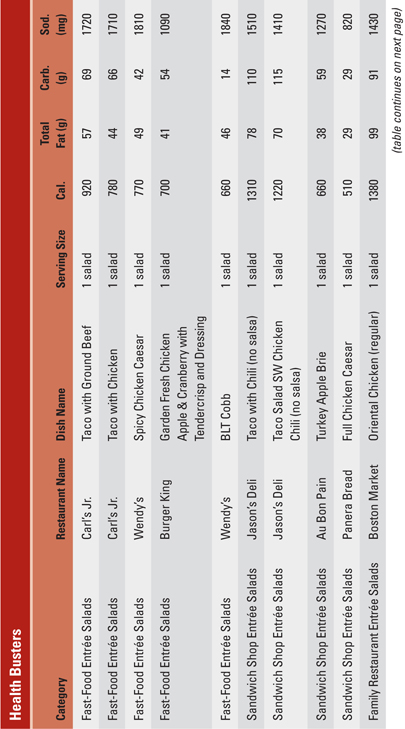



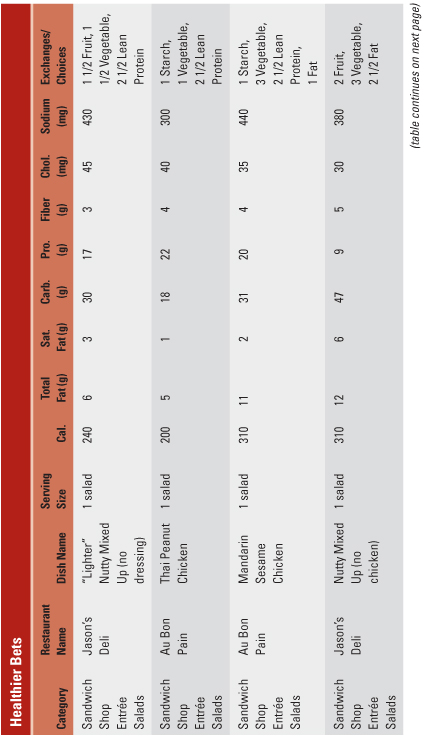
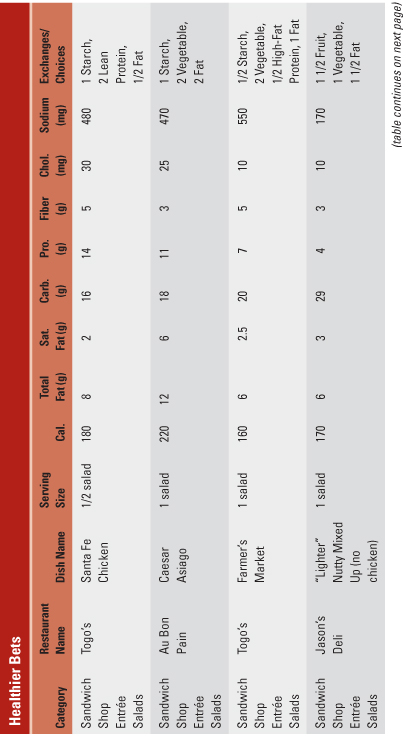



![]() Get It Your Way
Get It Your Way
• Replace fried items with grilled items. Instead of fried chicken, for example, request that grilled chicken top your salad. Or skip a crispy onion topping in favor of grilled or raw onions.
• Say “no, thank you” to bacon, cheese, sour cream, and other high-fat toppings. If you are craving bacon, ask for nuts, which have all of the crunch, but are a healthier source of fat. If you want the creaminess of sour cream, try sliced avocado or guacamole (if served), which are also healthy sources of fat.
• Ask for higher-fat (bacon, cheese, etc.) or higher-carbohydrate items (such as croutons) to be used sparingly. You’ll get all the flavor and texture, but in lesser amounts.
• Request the salad dressing on the side. Thin it with lemon juice (slices of limes or oranges work too), vinegar, or water.
• Scan the menu for other favorite vegetables that are not on the salad you plan to order. You can ask that these be added to your salad for more flavor and bulk.
![]() Tips and Tactics for Gluten-Free Eating
Tips and Tactics for Gluten-Free Eating
• Request that croutons or any other bread products be left off your salad. Bacon bits may contain gluten. A separate preparation area for your salad is ideal.
• If a salad typically includes croutons and the same person is preparing the gluten-free version of the salad, ask that they change gloves before preparing your salad.
• Avoid salad bars. It’s likely that not all of the ingredients are gluten-free. The scoops used for the various toppings don’t always stay where they belong, so they may become contaminated.
• Ask for salad dressing such as olive oil and balsamic or red wine vinegar or lemon to be served on the side or bring your own salad dressing.
![]() Tips and Tactics to Help Kids Eat Healthy
Tips and Tactics to Help Kids Eat Healthy
• Set an example. Kids are more likely to eat what they see a parent eating. If salads are a regular part of your meal, your child will be more likely to eat them.
• Think positively. Sure, salads may not be “kid food,” but your child doesn’t necessarily know that. Give your child lots of opportunities to try salads—you may be surprised by the results. Get an extra side plate and share your salad. Ask your child what vegetables from your salad they’d like to try. This is a good way to expose them to new or different ingredients.
• Use dressing as dip. It’s no secret that kids like to dip and dunk.
• Let your child be the chef. Kids who make their own meals are more likely to eat them. Have your child join you on a trip to the salad bar, letting him or her make a salad, with some guidance from you, of course.
![]() What’s Your Solution?
What’s Your Solution?
You’re at a business lunch in a local family restaurant. Your colleagues all opt for burgers and sandwiches, but you’re working hard to manage your weight, blood glucose, and blood pressure. You’re determined to order a salad for a lighter lunch. Still, you don’t want to seem like you’re being virtuous by ordering something healthy while everyone else indulges.
Which of the following could you order to meet your healthy eating goals without feeling awkward?
a) Order a Crispy Chicken Salad that comes with bacon, cheese, tomatoes, cucumber, and ranch dressing. It’s a salad, but the toppings are similar to what your colleagues are getting on their sandwiches and burgers, so you won’t feel out of place.
b) Order a Crispy Chicken Salad, but without the cheese and request the dressing on the side.
c) Order a Southwest Grilled Chicken salad, which comes with fried tortilla strips, grilled vegetables, black beans, avocado, cheese, and a spicy ranch dressing.
d) Order a Southwest Grilled Chicken salad, without the fried tortilla strips and cheese. Plus, request a vinaigrette dressing and slices of fresh lime on the side, in place of the spicy ranch dressing.
See the end of the chapter for answers.
![]() Menu Samplers
Menu Samplers


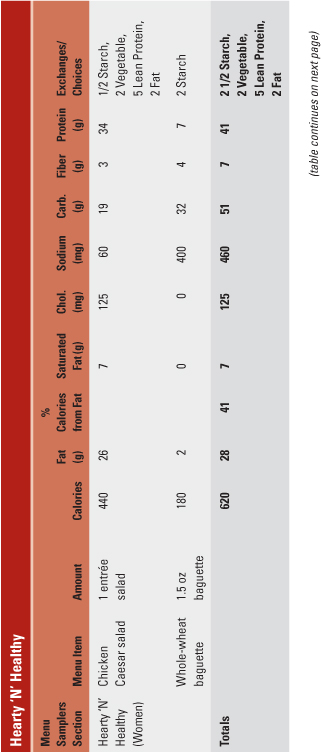

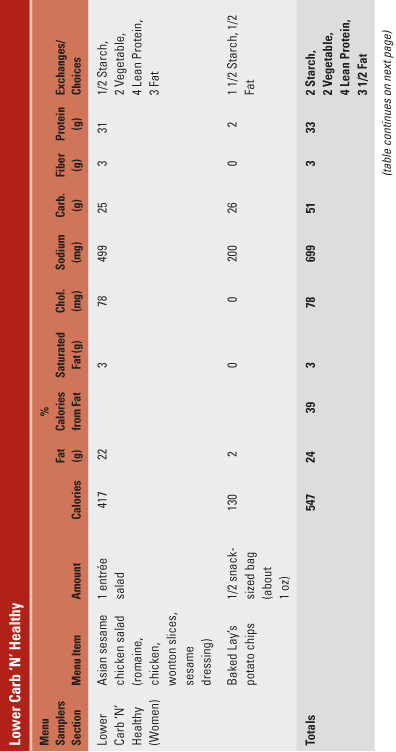

![]() What’s Your Solution? Answers
What’s Your Solution? Answers
a) Even though this is a salad, it likely contains more than 1,000 calories and loaded with fat. You’d have been better off choosing a simple sandwich or burger, and ordering a side salad.
b) These changes are a step in the right direction and will save you 100–300 calories. Make the salad even healthier by requesting grilled chicken and asking for only half the bacon.
c) Because this salad has grilled chicken and no bacon, it automatically has fewer calories and less fat than the Crispy Chicken Salad. If you’re self-conscious about ordering a salad, choose the healthiest one possible so you don’t have to request a lot of changes.
d) Now this is a great salad! It’s loaded with lots of satisfying flavors and crunch without a ton of fat. Your colleagues may be tempted to change their order to mimic yours.